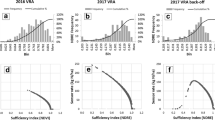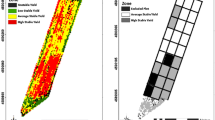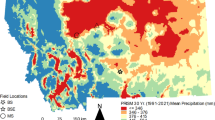Abstract
This research evaluated the profitability and nitrogen (N) efficiency of real time on-the-go optical sensing measurements (OPM) for variable-rate (VRT) N management for cotton. Two forms of OPM-based VRT N management and the existing farmer practice (FP) were used to determine N rates applied to cotton on 21 farm fields in the lower Mississippi River Basin states of Louisiana, Mississippi, Missouri and Tennessee, USA. A modified version of the Schabenberger and Pierce on-farm experimentation model was used to evaluate VRT N management and landscape, soil and weather factors on lint yields, N rates, N efficiency (lint yield divided by N rate) and net returns. Field level mean lint yields were not different between VRT and FP. VRT decreased N rates applied on four fields and increased N rates applied on four other fields. However, landscape, soil and weather attributes specific to fields influenced VRT N rates. VRT N rates were similar to FP N rates on the other fields in the study. N efficiency was not improved with VRT N management. N rates were not low enough to increase N efficiency. Changes in lint yields and N rates due to VRT coupled with USDA NRCS Environmental Quality Incentive Program cost-share payments were not sufficient to produce higher net returns relative to FP N management at the field level. In this multi-site, multi-year study, yields and net returns from VRT were not different from FPs which did not utilize variable rate N management.

Similar content being viewed by others
References
AAEA. (2000). Commodity costs and returns estimation handbook: A report of the AAEA task force on commodity costs and returns. Ames, IA, USA.
Alva, A. K., Paramasivam, S., Fares, A., Delgado, J. A., Mattos, D., Jr., & Sajwan, K. (2006). Nitrogen and irrigation management practices to improve nitrogen uptake efficiency and minimize leaching losses. Journal of Crop Improvement, 15, 369–420.
Arnall, D. B., Abit, M. J. M., Taylor, R. K., & Raun, W. R. (2016). Development of an NDVI-based nitrogen rate calculator for cotton. Crop Science, 56, 3263–3271.
ASABE. (2011). Agricultural machinery management data. ASAE D497.7. St. Joseph, MI, USA: American Society of Agricultural and Biological Engineers.
Biermacher, J. T., Brorsen, B. W., Epplin, F. M., Solie, J. B., & Raun, W. R. (2009a). The economic potential of precision nitrogen application with wheat based on plant sensing. Agricultural Economics, 40, 397–407.
Biermacher, J. T., Brorsen, B. W., Epplin, F. M., Solie, J. B., & Raun, W. R. (2009b). Economic feasibility of site-specific optical sensing for managing nitrogen fertilizer for growing wheat. Precision Agriculture, 10, 213–230.
Biermacher, J. T., Epplin, F. M., Brorsen, B. W., Solie, J. B., & Raun, W. R. (2006). Maximum benefit of a precise nitrogen application system for wheat. Precision Agriculture, 7, 193–204.
Boyer, C. N., Brorsen, B. W., Solie, J. B., & Raun, W. R. (2011). Profitability of variable rate nitrogen application in wheat production. Precision Agriculture, 12, 473–487.
Butchee, K. S., May, J., & Arnall, B. (2011). Sensor based nitrogen management reduced nitrogen and maintained yield. Crop Management, 10(1).
Casella, G., & Berger, R. L. (1990). Statistical inference. Pacific Grove, CA, USA: Duxbury.
Cassman, K. G., Gines, G. C., Dizon, M. A., Samson, M. I., & Alcantara, J. M. (1996). Nitrogen-use efficiency in tropical lowland rice systems: Contributions from indigenous and applied nitrogen. Field Crops Research, 47, 1–12.
Cassman, K. G., Peng, S., Olk, D. C., Ladha, J. K., Reichardt, W., Dobermann, A., et al. (1998). Opportunities for increased nitrogen-use efficiency from improved resource management in irrigated rice systems. Field Crops Research, 56, 7–39.
Griffin, T. W., Barnes, E. M., Allen, P. A., Andrade-Sánchez, P., Arnall, D. B., Balkcom, K., et al. (2014). Pooled analysis of combined primary data across multiple states and investigators for the development of a NDVI-based on-the-go nitrogen application algorithm for cotton. ASABE Paper No. 141900279. St Joseph, MI, USA: American Society of Agricultural and Biological Engineers.
Larson, J. A., Mooney, D. F., Roberts, R. K., & English, B. C. (2010). A computer decision aid for the cotton precision agriculture investment decision. In R. Khosla (Ed.), Proceedings of the 10th international conference on precision agriculture. Monticello, IL, USA: ISPA. Retrieved August 15, 2018, from https://www.ispag.org/proceedings/?action=year_abstracts.
Letner, M., & Bishop, T. (1993). Experimental design and analysis. Blacksburg, VA, USA: Valley Book Company.
Littell, R. C., Milliken, G. A., Stroup, W. W., Wolfinger, R. D., & Schabenberger, O. (2006). SAS ® for mixed models (2nd ed.). Cary, NC, USA: SAS Institute Inc.
Mooney, D. F., Roberts, R. K., English, B. C., Lambert, D. M., Larson, J. A., Velandia, M., et al. (2010). Precision farming by cotton producers in twelve southern states: Results from the 2009 southern cotton precision farming survey. Research Report 10-02. Department of Agricultural & Resource Economics, The University of Tennessee, Knoxville, USA.
Ortiz-Monasterio, J. I., & Raun, W. R. (2007). Reduced nitrogen and improved farm income for irrigated spring wheat in the Yaqui Valley, Mexico, using sensor based nitrogen management. Journal of Agricultural Science, 145, 1–8.
PRISM, Climate Group. (2014). Northwest alliance for computational science & engineering. Oregon State University. Retrieved August 15, 2018, from http://www.prism.oregonstate.edu/recent/.
Raun, W. R., Solie, J. B., Johnson, G. V., Stone, M. L., Mullen, R. W., Freeman, K. W., et al. (2002). Improving nitrogen use efficiency in cereal grain production with optical sensing and variable rate application. Agronomy Journal, 94, 815–820.
Raun, W. R., Solie, J. B., Stone, M. L., Martin, K. L., Freeman, K. W., Mullen, R. W., et al. (2005). Optical sensor-based algorithm for crop nitrogen fertilization. Communications in Soil Science and Plant Analysis, 36, 2759–2781.
Schabenberger, O., & Pierce, F. J. (2002). Contemporary statistical models for the plant and soil sciences. Boca Raton, FL, USA: CRC Press LLCC.
Scharf, P. C., Shannon, D. K., Palm, H. L., Sudduth, K. A., Drummond, S. T., Kitchen, N. R., et al. (2011). Sensor-based nitrogen applications out-performed producer-chosen rates for corn in on-farm demonstrations. Agronomy Journal, 103, 1683–1691.
Tiessen, H., Cuevas, E., & Chacon, P. (1994). The role of soil organic matter in sustaining soil fertility. Nature, 371, 783–785.
U.S. Department of Agriculture (USDA). (2012). Census of agriculture. 2012 Census Volume 1, Chapter 1: State level data. Retrieved August 15, 2018, from https://www.agcensus.usda.gov/Publications/2012/Full_Report/Census_by_State/.
U.S. Department of Agriculture (USDA). (2014a). Natural resources conservation service (NRCS). Environmental quality incentives program. Retrieved August 15, 2018, from http://www.nrcs.usda.gov/wps/portal/nrcs/main/national/programs/financial/eqip/.
U.S. Department of Agriculture (USDA). (2014b). Natural resources conservation service: Soils. SSURGO database. Retrieved August 15, 2018, from http://www.nrcs.usda.gov/wps/portal/nrcs/detail/soils/survey/?cid=nrcs142p2_053627.
U.S. Department of Agriculture (USDA). (2014c). National resources conservation service: Soils. Soil texture calculator. Retrieved August 15, 2018, from http://www.nrcs.usda.gov/wps/portal/nrcs/detail/soils/survey/?cid=nrcs142p2_054167.
U.S. Department of Agriculture (USDA). (2014d). Agricultural research service. Revised universal soil loss equation, version 2. Retrieved August 15, 2018, from http://fargo.nserl.purdue.edu/rusle2_dataweb/RUSLE2_Index.htm.
U.S. Department of Agriculture (USDA). (2014e). National agriculture statistics service. Cotton, price received, measured in $/lb. Retrieved August 15, 2018, from http://quickstats.nass.usda.gov/.
U.S. Department of Agriculture (USDA). (2014f). National agriculture statistics service. Nitrogen, price paid, measured in $/ton. Retrieved August 15, 2018, from http://quickstats.nass.usda.gov/.
U.S. Department of Agriculture (USDA). (2014g). National agriculture statistics service: Mississippi. 2014 Statewide EQIP practice, ranking and rate information. Retrieved August 15, 2018, from https://www.nrcs.usda.gov/wps/portal/nrcs/detail/ms/programs/financial/eqip/?cid=stelprdb1193441.
U.S. Department of Agriculture (USDA). (2017). Natural resources conservation service. Mississippi River Basin healthy watersheds initiative. Retrieved August 15, 2018, from http://www.nrcs.usda.gov/wps/portal/nrcs/detailfull/national/programs/initiatives/?cid=stelprdb1048200.
U.S. Department of Commerce. (2014). Bureau of economic analysis. Implicit price deflators for gross domestic product. NIPA Table 1.1.9.
U.S. Geological Survey. (2014). National elevation dataset: Metadata. Retrieved August 15, 2018, from https://nationalmap.gov/elevation.html.
Wright, D. L., Sprenkel, R. K., & Marois, J. J. (2015). Cotton growth and development. University of Florida IFAS extension. Retrieved August 15, 2018, from http://edis.ifas.ufl.edu/ag235.
Acknowledgements
This research was made possible with funding from USDA NRCS Conservation Innovation Grant Project No. 69-3A75-11-177, USDA Hatch Project TN TEN00442, and agricultural research institutions at Louisiana State University, Mississippi State University, University of Missouri, and University of Tennessee.
Author information
Authors and Affiliations
Corresponding author
Rights and permissions
About this article
Cite this article
Stefanini, M., Larson, J.A., Lambert, D.M. et al. Effects of optical sensing based variable rate nitrogen management on yields, nitrogen use and profitability for cotton. Precision Agric 20, 591–610 (2019). https://doi.org/10.1007/s11119-018-9599-9
Published:
Issue Date:
DOI: https://doi.org/10.1007/s11119-018-9599-9




